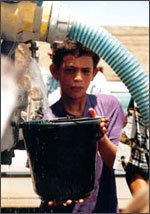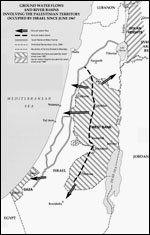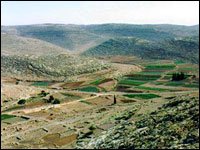

Water
Blood and Water, Part One
Israel and Palestine struggle over water in an arid land.
Jessica McCallin is a freelance journalist focusing on the interplay between environmental and economic issues, with a particular interest in environmental issues in the Middle East. She has written for a variety of U.K. and European environmental magazines, including the London Guardian, London Times, and Financial Times. |
Oil, namely the vast reserves in Iran, Iraq, and Saudi Arabia, is the cause of many of the broad geopolitical battles plaguing the Middle East. But it is access to water, a more fundamental resource, that is at the root of much of the bitter conflict between the Israelis and the Palestinians.
Case in point: The Palestinians say they rejected a recent peace proposal from Israel because, among other things, it didn’t give them control of water resources within their territory. Granted, it’s tough to figure out what’s to blame for the unravelling of the Middle East peace process, not least because there are so many issues on the table. But when viewed through the lens of one of those issues – access to water – the Palestinians seem to have a point.
|
The land that Israel and Palestine share is desert or semi-arid, so the limited amount of water in the area must be carefully managed if everyone is to get enough to ensure a decent standard of living. International law states that most of the water sources in the area are international resources, and as such must be shared by Israelis and Palestinians according to the principle of equitable and reasonable use.
Unfortunately, equitable and reasonable are two words that cannot be used to describe the water situation in Israel and Palestine.
At present, Israelis receive five times as much water per person as Palestinians. In Gaza, the disparity is even more striking, with settlers getting seven times as much water as their Palestinian neighbors. Stated differently, on average, Israelis get 92.5 gallons per person per day, while Palestinians in the West Bank get 18.5 gallons per person per day. The minimum quantity of water recommended by the U.S. Agency for International Development and the World Health Organization for household and urban use alone is 26.4 gallons per person per day.
Separate and Unequal
Yehezkel Lein from B’Tselem, the Israeli Information Center for Human Rights in the Occupied Territories, explains the origins of this discrepancy succinctly: “Underlying Israel’s water policy in the Occupied Territories was the desire to preserve the quantity of water it uses.”
|
Lein says a variety of methods were used to achieve this. First, Israel formalized the unequal division of the shared groundwater that was established prior to the occupation: capping Palestinian consumption, banning the digging of new wells, and putting quotas on how much water could be extracted from existing wells. Then it set about exploiting new water resources it didn’t control before the 1967 War, such as the Eastern Aquifer in the West Bank and the Gaza Aquifer. These new water resources primarily benefit the Israeli settlements that are still being established in those areas – even though those settlements are illegal. (Under international law, the West Bank and the Gaza Strip are defined as occupied territories and are therefore subject to the Geneva Conventions on the laws of war. The convention expressly prohibits moving people from the occupying county, i.e. Israel, into the occupied country, i.e. Palestine.)
Israel did hook some Palestinian towns into the water network – although nearly 30 percent of Palestinian homes have yet to be connected – but it did not provide appropriate maintenance work, with the result that, today, as much as half of the water meant to supply some Palestinian towns may be lost to leaking pipes, according to B’Tselem. The country also gave Israelis and settlers priority access to water: In the summer, when water is scare, the Israeli water company Mekorot shuts the valves of the main pipelines supplying Palestinian towns so that Israeli supplies remain unaffected.
The interim agreement of the Oslo peace process, signed by Israel and the Palestinian Authority in 1995, mandated zero reduction in the amount of water Israel was allowed to extract from the West Bank aquifers. Any additional water that the Palestinians needed was to come from new sources, not from a redistribution of existing sources. Israel, however, was given a veto on any water project aimed at tapping new sources and, over the past six years, has used that veto to block or delay almost all proposed projects.
|
When tensions between the two sides run high, as they have since September 2000 when the current uprising against the occupation started, the Palestinian water crisis becomes more desperate, especially for those without a connection to the water network. The Israeli policy of closure – whereby tanks and soldiers block entrances to Palestinian towns and villages, disrupting the normal flow of people and traffic – makes it difficult and dangerous for villagers to go to nearby wells and for water tankers to get into villages.
Human rights organizations are unanimous in condemning these policies, pointing out that they violate fundamental tenants of human rights law (such as the right to good health and an adequate subsistence) as well as fundamental tenants of international law (such as the ban on using resources from occupied territory and the ban on distributing water in a discriminatory way).
Such organizations also point out that Israel’s water policy heightens political resentment and, ultimately, makes reaching any peace agreement more difficult. No such agreement will be struck that does not entail a just resolution to the water issue.
Part II: Without fair water distribution, the Middle East peace process is all dried up
| Related Articles |
Occupied Salfit: Living in the Stench of Settlers’ Sewage and in the Shadow of the Apartheid Wall |
| Additional Resources |
| Organizations |
| Stay Informed |
|
Sign up for our mailing list and receive an email whenever we post a new article on our news site, Israel-Palestine News. |
This website is printer-friendly. Please Print this article and share it with your friends and family.




